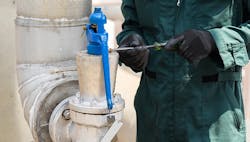A refiner hired me to review project drawings from one of the country’s largest engineering firms. I was aghast that one drawing showed two pressure relief valves (PRVs) in series. The only defense I heard was that the refiner had signed off on it.
A year later, I worked with a vendor of a twin-seal block valve investigating a mysterious failure of its valve in a refinery tank farm; we found that two PRVs in series accounted for that failure.
Pressure relief work is fairly intricate. Generally, companies set up “survey” teams that create their own, often flawed, design principles. I’ve worked on a few of these teams, so let me share some of what I’ve learned.
First, let’s look at the 3% pressure drop rule stated in API-520 “Sizing, Selection, and Installation of Pressure-Relieving Devices, Part II — Installation.” You should follow that rule. There may be wiggle room, as this video reveals, but even its presenter warns you shouldn’t deviate unless you’ve got a good lawyer.
[pullquote]
Another reason for keeping to the 3% rule is the pan-handle model for pressure drop calculation: a drop above 15% requires using an assumption of either isothermal or adiabatic conditions, neither of which can be modeled easily for two-phase flow. Besides, once you see drops that high, the Mach number rises and gas flow gets unstable (much worse with two phases). As a rule of thumb, a Mach number above 0.7 is extremely noisy.
Second, every pressure vessel should get a relief device. You may be able to ensure a vessel is connected to another without the risk of isolation but you can’t guarantee a pressure event will affect the two vessels in the same way. Fires are unpredictable, so don’t try to handicap a fire. Too often, I’ve seen designs with a single relief device protecting several vessels as a group. API and ASME require individual protection.
Third, no such thing as a winning relief scenario may exist. You can’t protect a reboiler from a fire by securing it from a stuck-open steam valve with a flow orifice. You must weigh each scenario on its own merits and decide if your solution protects against each credible scenario.
Fourth, let’s consider insulation credit for the fire scenario. API-2000 “Venting Atmospheric and Low-Pressure Storage Tanks” discusses the heat absorbed by a pool fire in detail and covers the use of an F-factor, an allowance for insulation. API provides a calculation procedure for reducing F and, thereby, Q (the BTU/h absorbed by the vessel wall). Generally, engineering firms resist using an F below 0.3 (1 in. of insulation) because they justifiably are wary that the insulation will get proper maintenance.
There’s a general understanding about what qualifies as in-place insulation that can resist a fire. The only acceptable jacket is stainless steel; the straps holding the insulation in place must be stainless steel or another metal with a suitably high melting point. Also, the insulation must not burn or decompose at the temperature limit expected in a pool fire. Per API-521, 5.15.1.2.2, this is 1,300°F or the practical limit of the vessel wall (heads generally fail last) at the corresponding vessel design pressure.
Fifth, every vessel with a liquid has a fire scenario — even a tank filled with water. I recommend tank designers use a fire case for ease of sizing the relief nozzle, then raising the nozzle to the next full size.
Volatile, flammable liquids always pose the question of which latent heat to use to calculate the relief flow rate. The accepted practice is the liquid after the third flash; however, I suggest looking for the maximum flow rate because that will open the relief device.
Sixth, thermal expansion should include all the pipe around a valve (you may need more than one valve) and heating from other sources.
Seventh, the relieving temperature in a fire case depends on the vapor pressure of the liquid composition. This must exceed the normal operating temperature.
Eighth, the 25-ft rule in fire sizing only applies for isolated vessels. If a vessel is inside and a pool fire could occur on any floor around the vessel, the fire area must include that part of the vessel wall.
Lastly, forget about fire-sizing for a gas-filled vessel. Vessel rupture occurs before the PRV opens.
DIRK WILLARD is a Chemical Processing Contributing Editor. You can email him at [email protected]
About the Author

Dirk Willard
Contributing Editor
DIRK WILLARD is a former ASBPE award-winning columnist for Chemical Processing's Field Notes column. During his 10+ years as a contributing editor for CP, he wrote hundreds of valuable and insightful pieces on design and operational issues. He retired in 2023.
